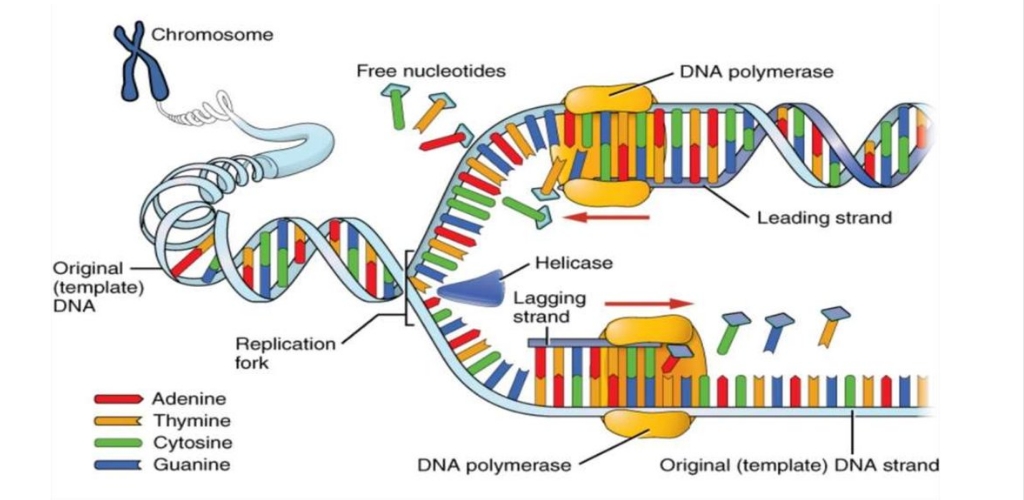DNA replication in eukaryotes is a complex and tightly regulated process that involves several enzymes and proteins. It is essential for the duplication of cells and the maintenance of the eukaryotic genome. This blog post will discuss the three main stages of eukaryotic DNA replication: initiation, elongation, and termination.
Initiation
During initiation, eukaryotic DNA is bound to histone proteins to form structures called nucleosomes. The DNA must be made accessible to the proteins and enzymes involved in the replication process. There are specific chromosomal locations called origins of replication where replication begins. In some eukaryotes, like yeast, these locations are defined by having a specific sequence of base pairs to which the replication proteins bind. In other eukaryotes, like humans, there does not appear to be a consensus sequence for their origins of replication.
Initiation involves the following steps:
- The DNA is unwound by DNA helicases, forming a replication fork containing two single-stranded templates.
- The replication fork is extended in both directions, creating a replication bubble.
- The origin of replication is a specific chromosomal location where replication begins.
Elongation
During elongation, an enzyme called DNA polymerase adds DNA nucleotides to the 3′ end of the newly synthesized template strand. The template strand specifies which of the four DNA nucleotides (A, T, C, or G) is added at each position along the new chain.
Elongation involves the following steps:
- A primer sequence is added with complementary RNA nucleotides, which are then replaced by DNA nucleotides.
- The leading strand is made continuously, while the lagging strand is synthesized in a discontinuous manner.
- DNA polymerase is involved in synthesizing the new DNA strands.
Termination
DNA replication in eukaryotes occurs in three main stages: initiation, elongation, and termination. During termination, the replication process ends, and the newly synthesized DNA strands are separated and prepared for cell division.
Disease Terminologies and Genetic Testing
Replication defects can cause conditions like trisomy, nullisomy, and Down syndrome. These conditions can be detected through prenatal genetic testing, which can help identify potential genetic abnormalities in a developing foetus. Prenatal genetic testing can be performed using various techniques, such as amniocentesis, CVS, and foetal blood sampling.
Some diseases related to DNA replication include:
Trisomy: A condition where an individual has three copies of a particular chromosome instead of the usual two. This can lead to various developmental and intellectual disabilities.
Nullisomy: A condition where an individual has no functional copies of a particular chromosome. This can result in the absence of certain genetic information, leading to various health issues.
Down syndrome: A condition caused by the presence of extra genetic material from chromosomes. This can result in intellectual disabilities, congenital abnormalities, and other health issues
Conclusion
DNA replication in eukaryotes is a complex and essential process that ensures the accurate transmission of genetic information from one generation to the next. The initiation, elongation, and termination stages of replication are tightly regulated and involve several enzymes and proteins. Understanding the mechanisms of eukaryotic DNA replication is crucial for advancing our knowledge of genetics and the treatment of various diseases, including those related to DNA replication
Citations:
[1] https://youtube.com/watch?v=lkLAdgLbm-Y
[2] https://bio.libretexts.org/Bookshelves/Introductory_and_General_Biology/Book:_General_Biology_(Boundless)/14:_DNA_Structure_and_Function/14.03:_DNA_Replication/14.3C:_DNA_Replication_in_Eukaryotes
[3] https://en.wikipedia.org/wiki/Eukaryotic_DNA_replication
[4] https://bio.libretexts.org/Bookshelves/Microbiology/Microbiology_(Boundless)/07:_Microbial_Genetics/7.03:_DNA_Replication/7.3B:_DNA_Replication_in_Eukaryotes
[5] https://www.ncbi.nlm.nih.gov/pmc/articles/PMC7574821/




